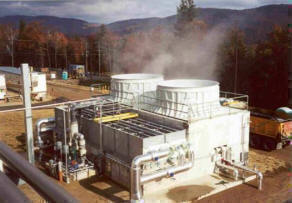
WSAC closed-loop, evaporative coolers and condensers

How WSAC systems work
In a WSAC system, warm process fluids or vapors are cooled in a closed-loop tube bundle (the process fluid being cooled never comes in contact with the outside air). Open loop water is sprayed and air is induced over the tube bundle resulting in the cooling effect. Some examples of cooling applications are:
| Cooling | Condensing |
| – Water – Glycol – Oil – Fuel – Gases |
– Steam – Ammonia – Propylene – Butane |
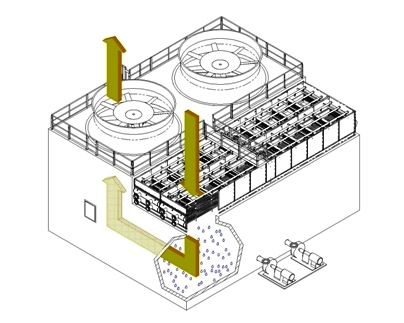
The Basics:
-
Air is induced downward over tube bundles
-
Water flows downward along with the air
-
Heat from the process stream is released to the cascading water
-
Vaporization transfers heat from the cascading water to the air stream
-
The air stream is forced to turn 180° providing maximum free water removal
-
Fans discharge air vertically at a high velocity to minimize recirculation
Outstanding Performance
The WSAC system is one of the most efficient and durable evaporative coolers available. A WSAC system can cool a process fluid to within 5oF of the surrounding wet bulb temperature.
The wet bulb temperature is the lowest temperature that can be obtained by evaporating water into the air. The wet bulb is determined by a combination of relative humidity and ambient air temperature. For example if the relative humidity is 60%, and the ambient air temperature is 70oF, the corresponding wet bulb temperature is 61oF. Over the past 100+ years, Niagara has mastered the art of designing each cooler specifically to the needs of each application.
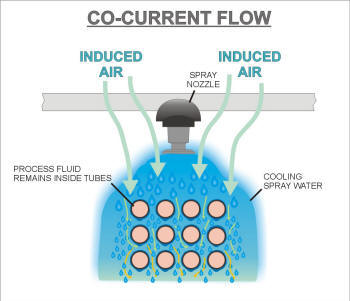
Liquid cooling
• Up to max inlet temp of 180°F
Single phase gas cooling
• Up to max inlet temp of 450°F
Turbine exhaust vacuum steam condensing
• As low as 1.8” HgA min
The WSAC cooler or condenser operates with induced draft co-current flow, which means that the air and spray water are both traveling in a downward direction across the tube bundle. This configuration ensures that spray water is evenly distributed over the entire tube surface and essentially minimizes the risk of fouling.
Other cooling methods use a counter-current flow, (air traveling up and spray water traveling down). This creates turbulence on the bottom of the tube. This turbulence results in incomplete distribution of the spray water over the tubes, which leads directly to fouling of the tube surface and a drop off in thermal performance.
As the cascading spray water mixes with the air, an equilibrium temperature forms as the water evaporates to the air, thus the warmed air and water mix together in the plenum/basin area providing inherent freeze protection during operation. Heaters can be included for non-operational cycles.
Variations
Niagara offers two variations of WSAC systems.
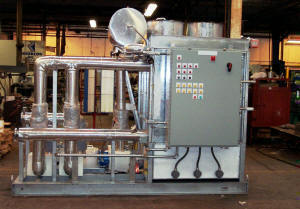
Skidded Prepackaged Unit
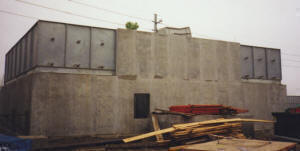
Field Erected Unit
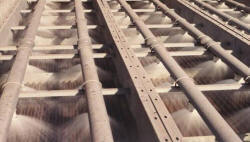
Uniform Spray Pattern
Prepackaged Niagara units, like the one pictured are designed as a single skid with no field assembly required. These units can be shipped directly to the job site for easy and immediate installation. Field erected units like the one pictured are the largest design type Niagara offers. Constructed using either concrete or FRP (Fiberglass Reinforced Plastic), field erected Niagara units offer the ability to cool high volumes of process fluid in a smaller plot area (footprint) than a traditional cooling tower. Observation and maintenance of the spray water distribution system can be accomplished without structure entry, fan shut down, or pump shutdown, providing 24 hour operation. Access doors and hatches also allow for cleaning and inspection of the lower water basin.